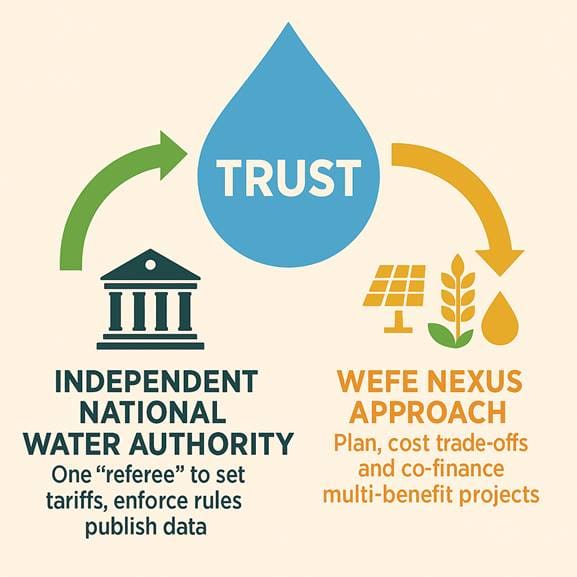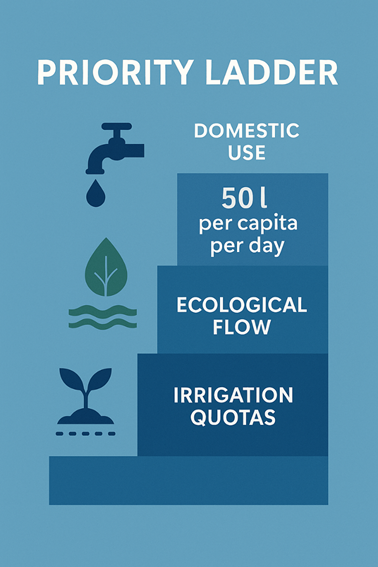Syria’s Next Turning Point: Who (and What) Should Run the Taps?

Syria’s most decisive reconstruction battle won’t be fought on city streets, it will be won or lost at the kitchen sink. After a decade of conflict, earthquake damage and worsening droughts, the question is no longer whether to reform water governance, but how. Two big ideas dominate the debate:
- Create an independent national water authority: a single “referee” that can cut through the tangle of several ministries and dozens of local councils, set tariffs, enforce rules, and publish honest data.
- Adopt a Water-Energy-Food-Ecosystems (WEFE) nexus approach: a planning frame that forces every sector to put its cards on the table, cost trade-offs and co-finance projects that deliver more than one benefit.
Conventional wisdom says you must pick one. In reality, Syria needs both stitched together into a single operating system that places trust at the center of every pipeline, solar panel, and wheat field.

Why a Stand-Alone Regulator Looks Attractive?
- Clarity in a fog of mandates. Right now no single entity can be held responsible for leak losses, tariff arrears, or illegal wells. An arm’s-length regulator collapses the decision maze, turning finger-pointing into accountability.
- Investor magnet. Donors and capital markets price risk; an independent referee with predictable rules lowers it. That unlocks the billions of dollars Syria needs for pump stations, chlorination, smart meters, and drought-resilient irrigation.
- Data credibility. When performance dashboards come from a body that answers to parliament (not a ministry with skin in the game), numbers gain authority, and citizens start believing what they read.
The catch? A water-only watchdog can drift into its own silo, blind to the diesel shortage that shuts down pumps or the cotton subsidy that drains aquifers.
Why the WEFE Lens Feels Urgent?
- Reality check. Agriculture swallows ≈ 87 % of Syrian withdrawals. Energy blackouts, food-price spikes, and ecosystem collapse are all water stories in disguise.
- Transboundary peace-making. Nexus modelling on Syria’s transboundary rivers (e.g., Orontes, Euphrates) shows that coordinated flow, crop, and power scenarios can lower diplomatic heat faster than any standalone water treaty.
- Innovation runway. Solar-powered well fields in Idlib and Aleppo already prove that a kilowatt saved is a cubic meter gained. Nexus thinking scales up such co-benefits.
The catch? Without a legal enforcement anchor, WEFE can stay a “pretty graphic,” great for workshops, and weak on binding allocation.
The Hybrid Blueprint: One Authority, Nexus DNA
1. Bake WEFE into the statute.
Give the regulator not just pipes and prices, but a legal duty to publish an annual water-budget table: drinking water, irrigation, power-generation releases, and ecological flows side by side, costed and transparent.
2. Share the boardroom.
Reserve seats for the Energy and Agriculture ministries, plus civil society and women’s organisations. When everyone who can break the system also has to sign off on its schedule, promises start to stick.
3. Pilot, prove, scale.
- North-west solar-pumping cluster. Bolt solar arrays to rehabilitated boreholes, monitor groundwater in real time, and show that every renewable kilowatt keeps urban taps running.
- Middle Euphrates drip corridor. Tie drip-conversion grants to a guaranteed transfer of saved water to Raqqa’s municipal network—justice in litres.
- Barada headwaters eco-flow pact. Negotiate a small ecological release alongside Damascus withdrawals so citizens can see the environment in the deal.
4. Lock priorities into law.
First 50 L per capita per day for domestic use, then ecological flow, then irrigation quotas. The ladder ends endless negotiation and shields the regulator from political storms.

Can Syria Actually Pull This Off?
- Physical headroom exists. Shifting just 15 % of irrigation demand to efficient systems frees more water than all Syrian cities now consume.
- Energy-water synergy is proven. The 1.5 MW solar field at al-Arshani and 340 kW at Atarib show cross-sector finance can be mobilized fast.
- Global precedent is solid. More than 30 countries have launched independent regulators in the past quarter-century, with credit-rating agencies routinely citing them as risk-reducers.
In short: Yes—if political will matches technical logic.
What Success Would Look Like
- Dashboards show leaks shrinking and chlorine residuals rising—updated daily, phone-friendly.
- Farmers tout drip lines not just for yields, but because the regulator signed their cost-share cheque.
- Bankers cite the authority’s credit-grade report when pricing reconstruction bonds.
- Women in basin councils out-vote a plan that would have starved household taps to save a prestige crop—live-streamed for everyone to see.
That mosaic spells trust, and trust is the only infrastructure that can outlast the next drought or budget cut.
Call to Action
If you’re drafting the new Water Law, embed WEFE powers into the regulator’s charter.
If you work in agriculture or energy, demand a seat at the table, and data you can verify.
If you’re a citizen or civil-society group, push your municipality to post its leaks fixed, litres delivered and funds spent.
Choosing between an independent water body and a WEFE approach is a false dilemma. Syria can, and must, walk both paths at once, binding them into one enforceable contract with its people. The taps, the crops and the riverbanks are waiting.